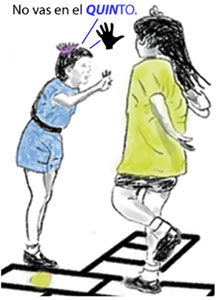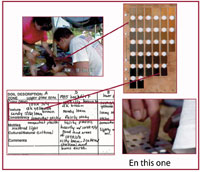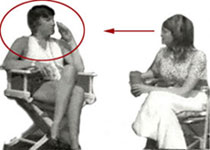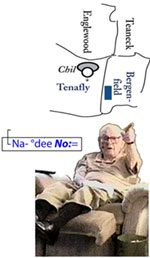| Research Projects
My research focuses on the practices human beings use to construct in concert with each other the social, cultural and cognitive worlds they inhabit. Central to this process are Language, structures for the organization of action-in-interaction, and an ecology of sign systems that includes not only talk, but also a range of different kinds of displays made by the body, and structure in the environment.
The Interactive Construction of Talk
Using as data videotapes recorded in range of natural settings I have investigated how utterances, sentences, and stories emerge not from a speaker alone, but rather through processes of interaction in which hearers of various types play a crucial role. Thus speakers who discover that they do have the gaze of a hearer, will produce restarts in their talk, an action that simultaneously functions as a request for the gaze of the hearer. Though typically dismissed as performance errors such actions both demonstrate the work that speakers do to construct coherent, grammatical sentences, not into the air, but for hearers who are actually attending them, and provide, within the stream of speech itself, crucial insights into language structure and grammatical organization. Speakers also reconstruct utterances, and the sentences emerging within them, as gaze is moved from one types of hearer to another so that the action in progress remains appropriate to its addressee of the moment.
Story Structure
Stories are organized as multi-party interactive fields, in which not only the talk of the speaker, but also the stance and embodied actions of hearers, characters cited in the talk who are present, etc. play a crucial role. The visible analysis that hearers are performing sheds new light on how participants differentiate alternative structural units within stories and make projections about upcoming events.
 |
Related Articles Notes on Story Structure and the Organization of Participation Audience Diversity, Participation and Interpretation Concurrent Operations on Talk The Negotiation of Coherence within Conversation Time in Action Embedded Context |
Participation
I investigate Participation as a temporally unfolding process through which separate parties demonstrate to each other their ongoing understanding of the events they are engaged in by building actions that contribute to the further progression of these very same events. Thus a hearer is not just a structural category, an addressee, but someone who displays detailed analysis of, and stance toward, the unfolding structure of the talk in progress through visible embodied displays. Speakers take such displays into account as they organize their own actions. Moreover, parties in interaction build action from the social positions they occupy. This approach to participation, with its focus on analysis displayed through temporally unfolding action, differs from approaches that proceed by constructing typologies of different kinds of participants.
 |
Related Articles Conversational Organization Notes on Story Structure and the Organization of Participation Audience Diversity, Participation and Interpretation Gesture and Coparticipation in the Activity of Searching for a Word Context, Activity and Participation Emotion within Situated Activity Time in Action Participation Action and Embodiment |
Scientific and Workplace Practice
Fieldwork in a number of scientific and workplace settings, including archaeological excavations, a chemistry lab, an oceanographic ship in the mouth of the Amazon, and the ramp and operations room of an airport, has led to analysis of how particular social groups construct the objects and ways of knowing that define their professional worlds through systematic interactive practices. Such settings constitute a perspicuous site for developing ways of analyzing human action that integrate the details of language use with participants’ orientation to an historically shaped material world. I was part of the Workplace Project, organized by Lucy Suchman at Xerox PARC in the early 1990’s.
  |
Related Articles Related Articles Notes on Story Structure and the Organization of Participation Audience Diversity, Participation and Interpretation Concurrent Operations on Talk The Negotiation of Coherence within Conversation Time in Action Embedded Context |
Human Vision as Social Practice
The social articulation of human vision is central to the organization of face-to-face interaction. As noted above speakers use gaze to make inferences about their hearers’ attention and orientation, and modify the talk that is emerging in terms of what they see. Central to many professions, such as archaeology, are practices for seeing and constituting in a complex perceptual environment the distinctive objects of knowledge, such as the traces of ancient societies visible in dirt being excavated, that define the expertise of a profession. Both scientific work environments, and the ways in which findings are organized and presented at meetings and in journals, make extensive use of historically shaped tools that structure vision and knowledge. Such tools are frequently articulated within interaction and contribute to the multimodal organization of action. The social organization of vision is crucial to the organization of action in many settings. The way in which the lawyers defending the policemen who beat Rodney King structured the jury’s perception of the videotape of the beating demonstrates the crucial importance of practices for shaping how others see consequential phenomena.
  |
Related Articles Professional Vision Practices of Seeing Conversational Organization Restarts, Pauses and the Achievement of Mutual Gaze Practices of Color Classification The Blackness of Black Vision Action and Embodiment Emotion within Situated Activity Pointing as Situated Practice The Body in Action |
Gesture and Embodiment
I have investigated the organization of gesture in face-to-face interaction and in the discourse of a man with severe aphasia. Some of my current research focuses on the organization of environmentally coupled gestures, which bring together talk, gesture and structure in the environment, in both scientific settings, and in children’s games such as hopscotch.
 |
Related Articles Gesture and Coparticipation in the Activity of Searching for a Word Time in Action Pointing as Situated Practice The Body in Action Conversational Frameworks for the Accomplishment of Meaning Action and Embodiment Seeing in Depth Gesture as a Resource for the Organization of Mutual Orientation |
Situated Temporalities and Projection
Much of my work has focused organization of units, such as utterances, sentences and stories in interaction, and on the resources used by participants to project upcoming events so that coordinated action can be accomplished.
| Related Articles Time in Action Conversational Organization The Interactive Construction of a Sentence Concurrent Operations on Talk Notes on Story Structure and the Organization of Participation Emotion within Situated Activity Situated Temporalities within Family Conflict |
Family Interaction
Since the early 1970’s I have recorded, and used as data, family interaction in range of settings (family dinners, picnics, family life in the home of a man with severe aphasia, etc.). In the early 1970’s I made films about family therapy at the Philadelphia Child Guidance clinic. I am currently a member of a multi-disciplinary research project research investigating the lives of middle class families.
| Related Articles Related Articles Notes on Story Structure and the Organization of Participation Conversational Frameworks for the Accomplishment of Meaning Situated Temporalities within Family Conflict |
Aphasia in Discourse
For many years I videotaped daily life in the home of a man who could speak only three words Yes, No, and And because of a stroke in the left hemisphere of his brain. Despite the severity of his language impairment this man was able to function as a powerful actor in conversation by getting others to produce the talk that he needed. His situation demonstrates the usefulness of complementing research on aphasia that focuses on structures within the brain with analysis of the practices used by persons with aphasia to build meaning and action in concert with others. I have pursed aspects of this research in a number of articles. I also recently edited Conversation and Brain Damage which is one of the first volumes to bring together the work of a number of scholars in both the United States and Europe who are analyzing aphasia in discourse.
 |
Related Articles Conversation and Brain Damage Co-Constructing Meaning in Conversations with an Aphasic Man Emotion within Situated Activity Conversational Frameworks for the Accomplishment of Meaning Producing Sense with Nonsense Syllables Pointing and Collaborative Construction of Meaning in Aphasia |
Despite the diversity of settings examined all of my research focuses on how action is built within human interaction as participants attend to each other, the detailed organization of the talk in progress, and historically shaped structure within their environment.


